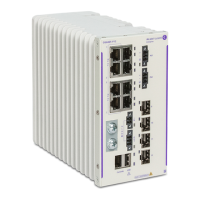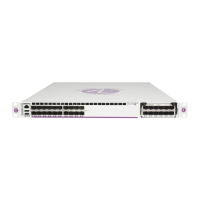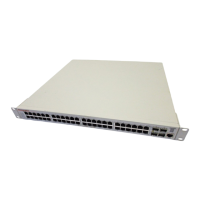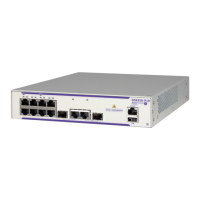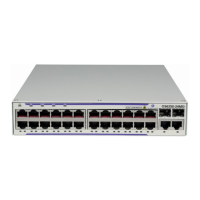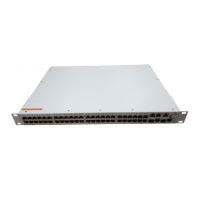Do you have a question about the Alcatel-Lucent OmniSwitch 6400 Series and is the answer not in the manual?
Lists OmniSwitch 6400 series models covered by this guide.
Lists OmniSwitch models not covered by this guide.
Identifies network administrators and IT support as the primary audience.
Details hardware components, configurations, and CLI commands covered in the guide.
Clarifies the guide focuses on hardware, not software configuration.
Outlines the documentation suite and stages of switch configuration.
Lists other relevant user manuals and technical tips for OmniSwitch 6400 Series.
Provides website link for accessing latest user guides and documentation.
Provides contact details and resources for technical assistance and product updates.
Details the various chassis types and their port configurations.
Explains hardware and software safeguards for data flow and uptime.
Lists different chassis models and their specific port layouts.
Identifies and describes front panel components of the OS6400-24.
Identifies and describes rear panel components of the OS6400-24.
Lists detailed technical specifications for the OS6400-24 model.
Identifies and describes front panel components of the OS6400-P24.
Identifies and describes rear panel components of the OS6400-P24.
Lists detailed technical specifications for the OS6400-P24 model.
Identifies and describes front panel components of the OS6400-U24.
Identifies and describes rear panel components of the OS6400-U24.
Lists detailed technical specifications for the OS6400-U24 model.
Identifies and describes front panel components of the OS6400-U24D.
Identifies and describes rear panel components of the OS6400-U24D.
Lists detailed technical specifications for the OS6400-U24D model.
Identifies and describes front panel components of the OS6400-48.
Identifies and describes rear panel components of the OS6400-48.
Lists detailed technical specifications for the OS6400-48 model.
Identifies and describes front panel components of the OS6400-P48.
Identifies and describes rear panel components of the OS6400-P48.
Lists detailed technical specifications for the OS6400-P48 model.
Explains the meaning of various LEDs on the switch front panels.
Lists the types of power supplies supported by the OmniSwitch 6400 Series.
Details specifications for different power supply models (e.g., 510W, 360W, 126W, 120W).
Covers AC power cord types and DC power supply requirements and wiring.
Describes the console port, default settings, and RJ-45 port pinouts.
Provides guidelines for proper switch placement and clearances for airflow and access.
Explains the airflow path through the chassis for cooling.
Outlines switch installation methods including tabletop and rack-mount.
Details steps for installing the switch on a table surface.
Provides steps for mounting the switch in a standard equipment rack.
Explains how to connect multiple switches to form a virtual chassis.
Covers procedures for installing and connecting AC and DC power supplies, including rack mounting.
Details how to connect the switch to AC and DC power sources.
Describes how to replace power supplies without powering down the switch.
Explains the process of powering on individual switches and stacked configurations.
Covers checking overall chassis, temperature, fan, and power supply status via CLI commands.
Lists general specifications for PoE support, standards, and port capabilities.
Shows how to check the operational status of installed power supplies.
Details how to enable/disable PoE, set power allocation, and priority levels.
Explains the function of priority disconnect during power budget constraints.
Describes CLI commands for monitoring PoE port statistics and slot allocation.
Introduces stack concepts, capacity expansion, and redundancy features.
Defines primary, secondary, and idle roles for switches in a stack.
Explains selection based on MAC address, saved slot number, and switch uptime.
Details selection based on stacking connection and saved slot information.
Describes the function of idle modules and the pass-through error state.
Explains how redundant stacking cables provide fault tolerance.
Covers dynamic and manual assignment of slot numbers and reverting to dynamic.
Details procedures for adding or removing modules from a stack.
Covers reloading primary, secondary, idle, and all switches in a stack.
Explains how to manually promote the secondary module to primary.
Describes the process of synchronizing configuration files across stack modules.
Lists CLI commands for monitoring stack topology, status, and modules.
Lists CLI commands executable on both primary and secondary management modules.
States compliance with essential EU directives for electrical safety and EMC.
Lists hazardous substances in components as required by China RoHS regulations.
Provides information on product end-of-life treatment and disposal in EU countries.
Lists safety agency certifications and EMI/EMC standards the product complies with.
Details compliance statements for FCC, Canada, VCCI, and other regional regulations.
Provides safety warnings in multiple languages for installation and operation.
Emphasizes correct grounding procedures to prevent electrical shock hazards.
Warns about electrostatic discharge and the use of anti-static wrist straps during installation.
Lists OmniSwitch 6400 series models covered by this guide.
Lists OmniSwitch models not covered by this guide.
Identifies network administrators and IT support as the primary audience.
Details hardware components, configurations, and CLI commands covered in the guide.
Clarifies the guide focuses on hardware, not software configuration.
Outlines the documentation suite and stages of switch configuration.
Lists other relevant user manuals and technical tips for OmniSwitch 6400 Series.
Provides website link for accessing latest user guides and documentation.
Provides contact details and resources for technical assistance and product updates.
Details the various chassis types and their port configurations.
Explains hardware and software safeguards for data flow and uptime.
Lists different chassis models and their specific port layouts.
Identifies and describes front panel components of the OS6400-24.
Identifies and describes rear panel components of the OS6400-24.
Lists detailed technical specifications for the OS6400-24 model.
Identifies and describes front panel components of the OS6400-P24.
Identifies and describes rear panel components of the OS6400-P24.
Lists detailed technical specifications for the OS6400-P24 model.
Identifies and describes front panel components of the OS6400-U24.
Identifies and describes rear panel components of the OS6400-U24.
Lists detailed technical specifications for the OS6400-U24 model.
Identifies and describes front panel components of the OS6400-U24D.
Identifies and describes rear panel components of the OS6400-U24D.
Lists detailed technical specifications for the OS6400-U24D model.
Identifies and describes front panel components of the OS6400-48.
Identifies and describes rear panel components of the OS6400-48.
Lists detailed technical specifications for the OS6400-48 model.
Identifies and describes front panel components of the OS6400-P48.
Identifies and describes rear panel components of the OS6400-P48.
Lists detailed technical specifications for the OS6400-P48 model.
Explains the meaning of various LEDs on the switch front panels.
Lists the types of power supplies supported by the OmniSwitch 6400 Series.
Details specifications for different power supply models (e.g., 510W, 360W, 126W, 120W).
Covers AC power cord types and DC power supply requirements and wiring.
Describes the console port, default settings, and RJ-45 port pinouts.
Provides guidelines for proper switch placement and clearances for airflow and access.
Explains the airflow path through the chassis for cooling.
Outlines switch installation methods including tabletop and rack-mount.
Details steps for installing the switch on a table surface.
Provides steps for mounting the switch in a standard equipment rack.
Explains how to connect multiple switches to form a virtual chassis.
Covers procedures for installing and connecting AC and DC power supplies, including rack mounting.
Details how to connect the switch to AC and DC power sources.
Describes how to replace power supplies without powering down the switch.
Explains the process of powering on individual switches and stacked configurations.
Covers checking overall chassis, temperature, fan, and power supply status via CLI commands.
Lists general specifications for PoE support, standards, and port capabilities.
Shows how to check the operational status of installed power supplies.
Details how to enable/disable PoE, set power allocation, and priority levels.
Explains the function of priority disconnect during power budget constraints.
Describes CLI commands for monitoring PoE port statistics and slot allocation.
Introduces stack concepts, capacity expansion, and redundancy features.
Defines primary, secondary, and idle roles for switches in a stack.
Explains selection based on MAC address, saved slot number, and switch uptime.
Details selection based on stacking connection and saved slot information.
Describes the function of idle modules and the pass-through error state.
Explains how redundant stacking cables provide fault tolerance.
Covers dynamic and manual assignment of slot numbers and reverting to dynamic.
Details procedures for adding or removing modules from a stack.
Covers reloading primary, secondary, idle, and all switches in a stack.
Explains how to manually promote the secondary module to primary.
Describes the process of synchronizing configuration files across stack modules.
Lists CLI commands for monitoring stack topology, status, and modules.
Lists CLI commands executable on both primary and secondary management modules.
States compliance with essential EU directives for electrical safety and EMC.
Lists hazardous substances in components as required by China RoHS regulations.
Provides information on product end-of-life treatment and disposal in EU countries.
Lists safety agency certifications and EMI/EMC standards the product complies with.
Details compliance statements for FCC, Canada, VCCI, and other regional regulations.
Provides safety warnings in multiple languages for installation and operation.
Emphasizes correct grounding procedures to prevent electrical shock hazards.
Warns about electrostatic discharge and the use of anti-static wrist straps during installation.
| Model | OmniSwitch 6400 Series |
|---|---|
| Layer | Layer 2/3 |
| Switching Capacity | Up to 128 Gbps |
| Forwarding Rate | Up to 95.2 Mpps |
| VLAN Support | Yes |
| IPv6 Support | Yes |
| Ports | 10/100/1000 |
| Power over Ethernet (PoE) | Yes, PoE/PoE+ support |
| Management | CLI, Web, SNMP |
| Form Factor | 1U rack-mountable |
| VLANs | 4096 |
| MAC Address Table Size | Up to 32, 000 |
| Power Supply | Redundant power supply option |
| Security Features | ACLs, 802.1X |
| Quality of Service (QoS) | Yes |
| Stacking | Yes |


